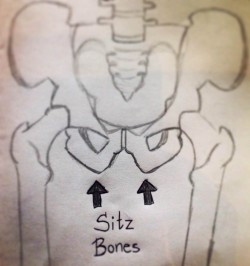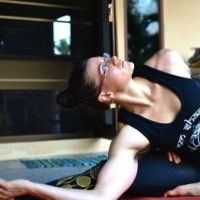In yoga, we want to create balance.
One major part of the human anatomy we work with is the pelvis. Some teachers cue the balancing of this as “tucking the tailbone.” However, students either don’t know what this means, the cue may not apply to their specific imbalances, or they end up looking like a kind of absurd bent-kneed stork or ashamed dog in attempting to follow the cue. But this is an important action that can relieve pain, retrain musculature, and teach you more body awareness; let’s explore the concept.
Why do I care about balancing my pelvis? Does it affect my health?
Remember—the desired result of “tucking the tailbone” is to balance the pelvis. This may mean tilting your pelvis forward, back, or side to side. Why does balance matter?
Because we are people of the digital age and we spend a lot of time crouched in front of our various glow boxes, our low backs and hamstrings are weak and tight, unevenly pulling on the bones of the spine and pelvis. Therefore, most people have an irregularly rotated pelvis and possible clicking in their hips, low back, or knees because the joints are pulled out of alignment by imbalanced muscles.
This can ultimately result in chronic pain, other areas of the body overcompensating and creating more issues, organ inflammation and muscle fatigue.
There are four common types of hip imbalances:
1. When the hamstrings are tight, they shorten and pull down on the pelvis, flattening out the lumbar spine, or lower back, which puts you at risk for a herniated disk, and can cause lower back pain. The fancy term for this is “thoracic kyphosis.”
2. The opposite may also occur, where the hamstrings are more flexible and the quadriceps are tight, so the pelvis tilts forward and causes an over arching of the lumbar spine, putting you are risk for pinched nerves and other, ripple-effect issues in the spine and neck. The fancy term for this is “lumbar lordosis.”
3. A person may lean forward, putting the weight on the front part of the feet and tilting the head forward of the spine. This creates a lot of weight and pulling on the C7 vertebrae (the tiny cervical vertebra at the junction of your neck and shoulders), which can cause an enlarged mass of tension in that area (a stress hump). The not-so-fancy term for this is “forward head.” This is why you may hear the cue “stack your skull on top of your spine,” as in a balanced body the ears should be right over the shoulders, and the weight evenly distributed in the four corners of the feet.
4. Then, you have the “sway back.” This is when you lean back on your heels, and crunch into your lower back. Your head is behind your spine, putting a lot of tension into your low back area.
I’ve included a visual below of these irregularities. All these postural irregularities have similar yet different effects on your body—resulting in low back pain, foot problems, knee problems and organ problems.
Okay, that does sound unpleasant. How can I learn to move and retrain my pelvis?
First, let’s talk about a part of your pelvis that can help you be more aware of the positioning of the hip girdle and move yourself into balance.
Sitz bones, sitting bones, sit bones; same same. These are the common names for the ischial tuberosity, and it’s the lowest of the three major bones that make up the pelvis (in Greek ischion means “hip”). It’s part of the pelvis that takes our weight when we sit.
Bringing awareness to this part of your hips can help you envision what it feels like to have a balanced pelvis. You can become more aware of pelvic imbalance and work on pointing the sitz bones to the floor.
Healing Imbalances through regular practice, body awareness, and habit breaking:
“Point your sitz bones to the floor,” “draw the navel in towards the spine” and “find equal pressure on all four corners of the feet” can work to bring the pelvis into balance for all irregularities; you don’t even need to be in a yoga class to do them! You also need to notice the movement patterns you have that have trained your body to be imbalanced in the first place.
In therapeutic yoga asana, we work to make—among other things—the hamstrings more flexible, by working with the sitz bones.
Ischial tuberosity pain, or pain in the sitz bone, is common in athletes and anyone doing any type of jumping, running, or long periods of sitting. The sitz bone is the point of origin for the inner thigh muscles and hamstrings. The hamstrings aren’t just one muscle—there are three (semitendinosus, semimembranosus, and the biceps femoris). That is a lot of tension that can develop in a single point IF the hamstrings are not stretched properly—in addition to strengthening and stretching the front of the thigh (quadriceps) as well.
However, our hamstrings are usually tight, and they tend to become tighter and tighter until it begins to affect our low back and have a ripple effect all the way up the spine, leading to chronic low back pain, sciatica problems, imbalances in the hip, imbalances in foot pressure and more.
When you go to an asana class, your teacher should be verbally if not physically adjusting you. Ask your instructor questions, “How is my posture?” “Is my pelvis balanced?” “Is this pose supposed to be a backbend or do I keep my spine straight?” “Can you check if I am putting more weight on one side of my feet?” “Is my back flat in this forward fold?” “Should I bend my knees or keep my legs straight when I stretch?”
Be courteous, ask before or after class. Your instructor will be glad to help you—and asking for help will let your instructor know that you have special concerns and are seeking more than a workout.
Remember, moving away from imbalance means being more aware of your movements and slowing the practice down. As much fun as it is to work up a sweat in a flowing vinyasa class, if you have an imbalance or tightness in your body, that style of asana class may only promote imbalance as we tend to move into our open and strong areas instead of working on tightness and weak spots.
To truly heal and promote vitality and self awareness, going to a slower, static class with long holds on a regular basis (two to three times a week) can give you the body awareness and tips you need to become more aware of your issues, in and outside of an asana class.
You may do things that feel weird or unnatural for you—movements which will bring you back into alignment and eventually create more freedom of movement. If you know you have body imbalances, look for a teacher who frequently cues and adjusts you. These are the teachers trained in body balance and anatomy. They are out there, but you may need to look for them. These teachers can show you the origins and movements which lead to your pain and imbalances.
People may find it difficult to release chronic or severe imbalances solely through the practice of yoga. A massage therapist well versed in the therapeutic use of trigger points can work with you to pinpoint the origins of the imbalance.
In conclusion, when yoga teachers ask someone to point your sitz bones to the floor or tuck your tailbone, they are asking the student to create balance in your pelvis to release the tight muscles in the hips and thighs, and to bring a sense of equilibrium to the spine. Please ask the yoga teacher to assist you manually through an adjust and/or practice in front of a mirror to get a feel for this subtle movement.
By bringing awareness to hip imbalances, everyone can work both in your daily life and in asana class to be more aware and present when and how they move. This awareness and development of new movement patterns can balance health by bringing equilibrium into the pelvic bowl and the musculature associated with it—effectively preventing tension, pain, and the disorders associated with it.
Relephant reads:
Alignment, Schmilignment: Questioning the Status Quo.
Author: Lindsay Trostle
Apprentice Editor: Renee Jahnke / Editor: Catherine Monkman
Images: Author’s Own/Kevin Dinkel-Flickr









Read 0 comments and reply